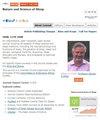基于机器学习的阻塞性睡眠呼吸暂停伴白天过度嗜睡患者 1 型嗜睡症预测模型
IF 3
2区 医学
Q2 CLINICAL NEUROLOGY
引用次数: 0
摘要
背景:白天过度嗜睡(EDS)是阻塞性睡眠呼吸暂停(OSA)和1型嗜睡症(NT1)的常见症状,而后者可能总是被忽视。机器学习(ML)模型可以实现对这些病症的早期检测,但从未应用于 NT1 的诊断:该研究旨在开发 ML 预测模型,以帮助非睡眠专科临床医生及早发现 OSA 患者合并 NT1 的高概率:方法:共收集并分析了三个睡眠中心 246 名 OSA 患者的临床特征,以建立九个 ML 模型。特征选择采用 LASSO 回归。采用接收者操作曲线下面积(AUC)、校准曲线和决策曲线分析(DCA)等各种指标来评估和比较这些多重L模型的性能。通过夏普利相加解释(SHAP)证明了模型的可解释性:结果:根据对 AUC、DCA 和校准曲线的分析,与其他机器学习(ML)模型相比,梯度提升机(GBM)模型表现出更优越的性能。按特征重要性排序,GBM 模型使用的前五个特征分别是发病年龄、总肢体运动指数、睡眠潜伏期、非快速眼动(REM)睡眠第二阶段和 OSA 的严重程度:该研究为早期识别 OSA 患者的 NT1 提供了一个简单可行的基于 ML 的筛查模型,值得在更广泛的临床实践中进一步验证。本文章由计算机程序翻译,如有差异,请以英文原文为准。
Machine learning-Based model for prediction of Narcolepsy Type 1 in Patients with Obstructive Sleep Apnea with Excessive Daytime Sleepiness
Background: Excessive daytime sleepiness (EDS) forms a prevalent symptom of obstructive sleep apnea (OSA) and narcolepsy type 1 (NT1), while the latter might always be overlooked. Machine learning (ML) models can enable the early detection of these conditions, which has never been applied for diagnosis of NT1.
Objective: The study aimed to develop ML prediction models to help non-sleep specialist clinicians identify high probability of comorbid NT1 in patients with OSA early.
Methods: Totally, clinical features of 246 patients with OSA in three sleep centers were collected and analyzed for the development of nine ML models. LASSO regression was used for feature selection. Various metrics such as the area under the receiver operating curve (AUC), calibration curve, and decision curve analysis (DCA) were employed to evaluate and compare the performance of these ML models. Model interpretability was demonstrated by Shapley Additive explanations (SHAP).
Results: Based on the analysis of AUC, DCA, and calibration curves, the Gradient Boosting Machine (GBM) model demonstrated superior performance compared to other machine learning (ML) models. The top five features used in the GBM model, ranked by feature importance, were age of onset, total limb movements index, sleep latency, non-REM (Rapid Eye Movement) sleep stage 2 and severity of OSA.
Conclusion: The study yielded a simple and feasible screening ML-based model for the early identification of NT1 in patients with OSA, which warrants further verification in more extensive clinical practices.
Objective: The study aimed to develop ML prediction models to help non-sleep specialist clinicians identify high probability of comorbid NT1 in patients with OSA early.
Methods: Totally, clinical features of 246 patients with OSA in three sleep centers were collected and analyzed for the development of nine ML models. LASSO regression was used for feature selection. Various metrics such as the area under the receiver operating curve (AUC), calibration curve, and decision curve analysis (DCA) were employed to evaluate and compare the performance of these ML models. Model interpretability was demonstrated by Shapley Additive explanations (SHAP).
Results: Based on the analysis of AUC, DCA, and calibration curves, the Gradient Boosting Machine (GBM) model demonstrated superior performance compared to other machine learning (ML) models. The top five features used in the GBM model, ranked by feature importance, were age of onset, total limb movements index, sleep latency, non-REM (Rapid Eye Movement) sleep stage 2 and severity of OSA.
Conclusion: The study yielded a simple and feasible screening ML-based model for the early identification of NT1 in patients with OSA, which warrants further verification in more extensive clinical practices.
求助全文
通过发布文献求助,成功后即可免费获取论文全文。
去求助
来源期刊

Nature and Science of Sleep
Neuroscience-Behavioral Neuroscience
CiteScore
5.70
自引率
5.90%
发文量
245
审稿时长
16 weeks
期刊介绍:
Nature and Science of Sleep is an international, peer-reviewed, open access journal covering all aspects of sleep science and sleep medicine, including the neurophysiology and functions of sleep, the genetics of sleep, sleep and society, biological rhythms, dreaming, sleep disorders and therapy, and strategies to optimize healthy sleep.
Specific topics covered in the journal include:
The functions of sleep in humans and other animals
Physiological and neurophysiological changes with sleep
The genetics of sleep and sleep differences
The neurotransmitters, receptors and pathways involved in controlling both sleep and wakefulness
Behavioral and pharmacological interventions aimed at improving sleep, and improving wakefulness
Sleep changes with development and with age
Sleep and reproduction (e.g., changes across the menstrual cycle, with pregnancy and menopause)
The science and nature of dreams
Sleep disorders
Impact of sleep and sleep disorders on health, daytime function and quality of life
Sleep problems secondary to clinical disorders
Interaction of society with sleep (e.g., consequences of shift work, occupational health, public health)
The microbiome and sleep
Chronotherapy
Impact of circadian rhythms on sleep, physiology, cognition and health
Mechanisms controlling circadian rhythms, centrally and peripherally
Impact of circadian rhythm disruptions (including night shift work, jet lag and social jet lag) on sleep, physiology, cognition and health
Behavioral and pharmacological interventions aimed at reducing adverse effects of circadian-related sleep disruption
Assessment of technologies and biomarkers for measuring sleep and/or circadian rhythms
Epigenetic markers of sleep or circadian disruption.
 求助内容:
求助内容: 应助结果提醒方式:
应助结果提醒方式:


